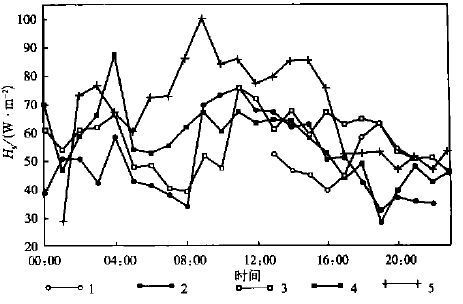1998年南海季风试验期间海 气通量的估算
Estimate of Air-sea Fluxes During South China Sea Monsoon Experiment in 1998
-
摘要: 根据1998年南海季风试验西沙海面铁塔梯度观测资料,利用总体(Bulk)系数法和多层结通量廓线法对西沙海面的海-气通量进行了估算,得出两种方法估算的潜热通量、感热通量基本一致。总体系数法估算的潜热通量比多层结通量廓线法略大1~3 W·m-2,感热通量小0~1.5 W·m-2。一般而言,季风爆发期间潜热输送逐渐增加;季风爆发前期夜间潜热通量比季风爆发后期大;季风爆发后期,白天潜热通量明显大于爆发初期和中期。感热通量季风爆发前海面向大气输送,爆发后期大气向海面输送。动量通量和摩擦速度随风速增加。Abstract: Based on the data of the South China Monsoon Experiment in 1998, the air-sea fluxes are estimated by using the bulk coefficient and multi-stratification formulas. The results of latent and the sensible heat fluxes by two methods are basically close. The latent heat flux is 1–3 W·m-2 larger and the sensible heat flux 0–1.5 W·m-2 smaller by the multi-stratification method than by the bulk coefficient method. Generally the latent heat flux increases gradually during the monsoon onset. The flux at night is larger before the monsoon onset than after. During the days, the flux is smaller in the beginning and middle of the monsoon onset period than the latter period. The sensible heat flux transports from the sea surface to atmosphere in the beginning of the monsoon onset and from the atmosphere to sea surface in the latter period of the monsoon onset. The momentum flux and friction velocity increase with speed.
-
Key words:
- Xisha;
- Tower observation;
- Air-sea fluxes;
- South China sea
-
表 1 1998年南海季风试验期间不同时段海面通量等物理量的估算值

-
[1] 江宁波, 罗会邦. 南海夏季风爆发前后亚洲地区大尺度环流突变. 热带气象学报, 1995, 11: 289-296. http://www.cnki.com.cn/Article/CJFDTOTAL-RDQX199504000.htm [2] 简茂球,乔云亭,罗会邦. 南海夏季风爆发前后低纬大气环流突变特征. 气候与环境研究. 2000, 5(4): 356~362. http://www.cnki.com.cn/Article/CJFDTOTAL-QHYH200004002.htm [3] 王世玉, 钱永甫. 1998年南海夏季风爆发前后区域加热的基本特征. 南海季风爆发和演变及其与海洋的相互作用. 北京:气象出版社, 1999. 43~47. [4] 谢安, 毛江玉, 叶谦. 海温纬向梯度与南海季风爆发. 南海季风爆发和演变及其与海洋的相互作用. 北京:气象出版社,1999.48~56. [5] 罗会邦. 南海夏季风爆发及相关雨带演变特征. 南海季风爆发和演变及其与海洋的相互作用. 北京:气象出版社,1999.25~29. [6] 马开玉,陈星,张跃存.气候诊断.北京:气象出版社,1996. [7] Fairall C W, Bradleym E F, Rogers D P, et al. Bulk parameterization of air-sea fluxes for tropical ocean-global atmosphere coupled-ocean atmosphere response experiment. J. Geophys. Res., 1996a, 101 (c2): 3747~3764. [8] Fairall C W, Godfrey J S, Wick G A, et al. Coolskin and warm-layer effects on sea surface temperature. J. Geophys. Res., 1996b, 101(c1): 1295~1308. [9] Zeng X, Zhao M, Dicdinson R E. Intercomparison of bulk aerodynamic algorithms TOGA COARE and TAO data. Journal of Climate, 1998, 11: 2628~2644. doi: 10.1175/1520-0442(1998)011<2628:IOBAAF>2.0.CO;2 [10] 曲绍厚, 胡非, 李亚秋. SCSMEX期间南海夏季风海气交换的主要特征. 气候与环境研究, 2000, 5(4): 441~444. http://www.cnki.com.cn/Article/CJFDTOTAL-QHYH200004008.htm -


 设为首页
设为首页 加入收藏
加入收藏



 下载:
下载:
